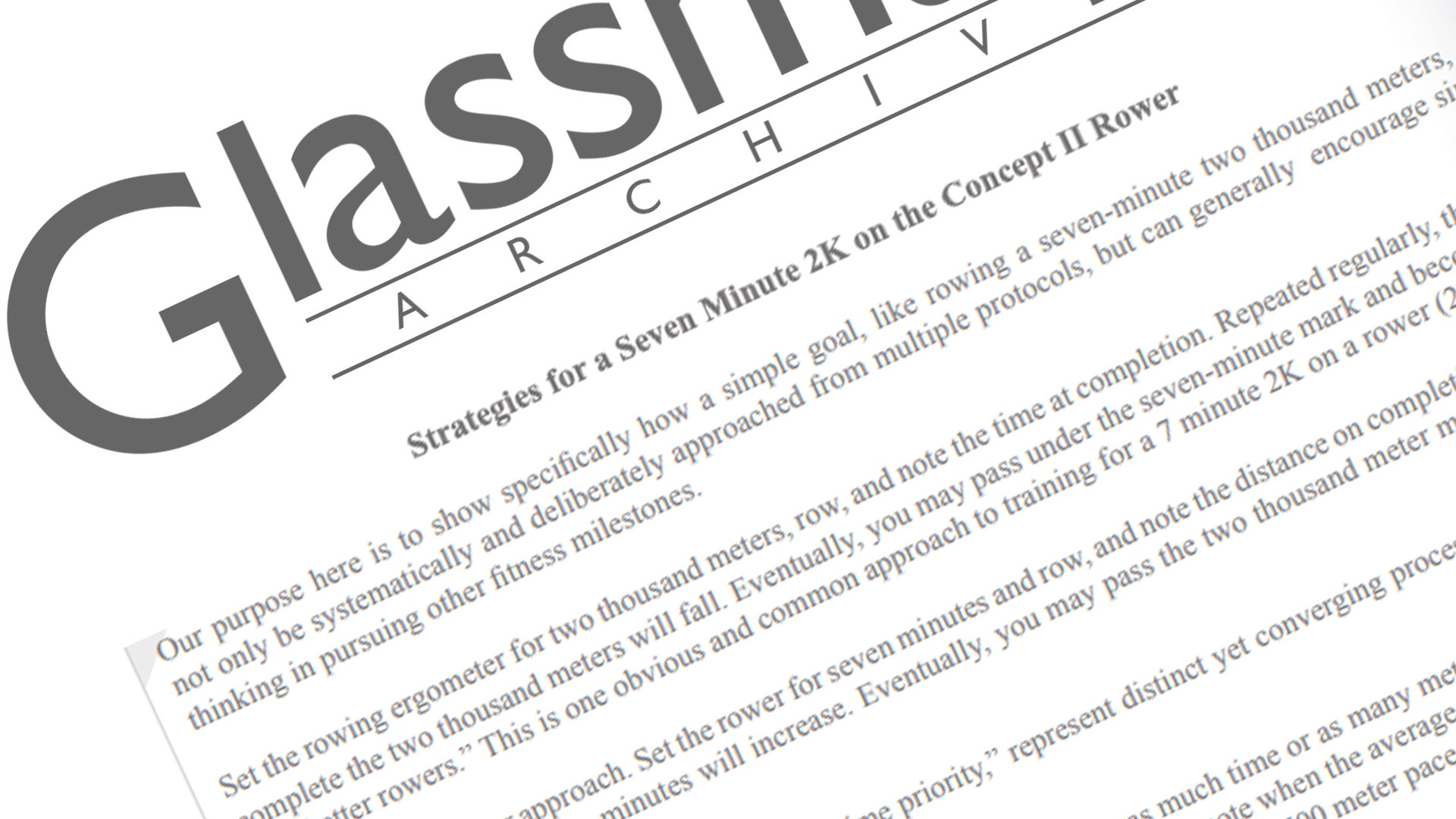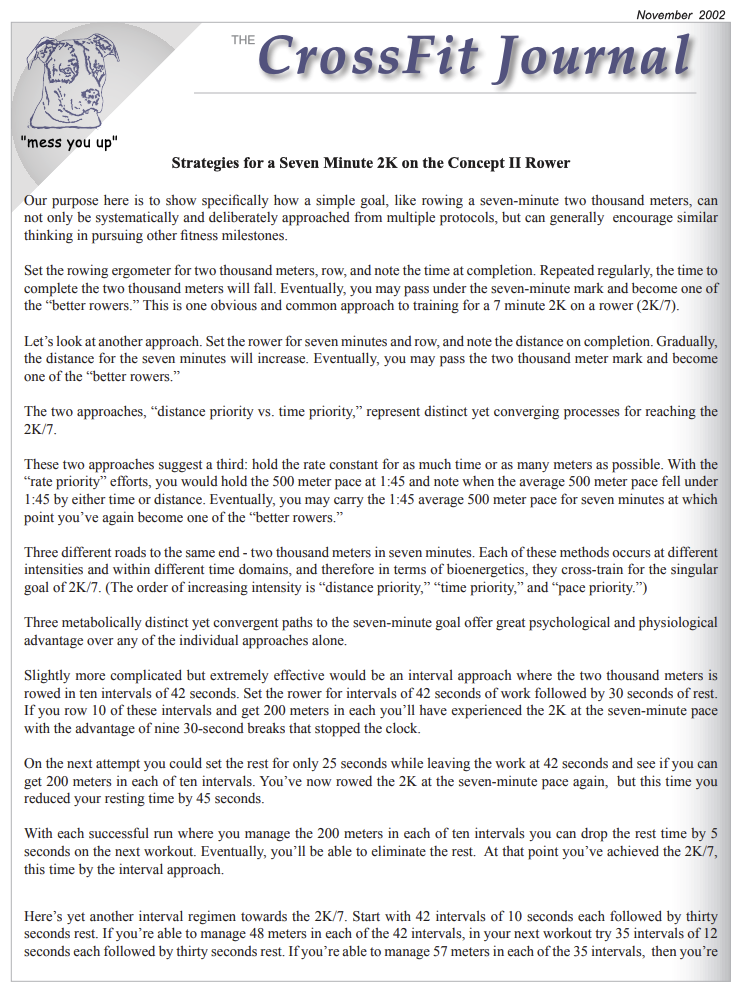Our purpose here is to show specifically how a simple goal, like rowing a seven-minute two thousand meters, can not only be systematically and deliberately approached from multiple protocols, but can generally encourage similar thinking in pursuing other fitness milestones. Set the rowing ergometer for two thousand meters, row, and note the time at completion. Repeated regularly, the time to complete the two thousand meters will fall. Eventually, you may pass under the seven-minute mark and become one of the “better rowers.” This is one obvious and common approach to training for a 7 minute 2K on a rower (2K/7).
Let’s look at another approach. Set the rower for seven minutes and row, and note the distance on completion. Gradually, the distance for the seven minutes will increase. Eventually, you may pass the two thousand meter mark and become one of the “better rowers.”
The two approaches, “distance priority vs. time priority,” represent distinct yet converging processes for reaching the 2K/7. These two approaches suggest a third: hold the rate constant for as much time or as many meters as possible. With the “rate priority” efforts, you would hold the 500 meter pace at 1:45 and note when the average 500 meter pace fell under 1:45 by either time or distance. Eventually, you may carry the 1:45 average 500 meter pace for seven minutes at which point you’ve again become one of the “better rowers.”
Three different roads to the same end – two thousand meters in seven minutes. Each of these methods occurs at different intensities and within different time domains, and therefore in terms of bioenergetics, they cross-train for the singular goal of 2K/7. (The order of increasing intensity is “distance priority,” “time priority,” and “pace priority.”) Three metabolically distinct yet convergent paths to the seven-minute goal offer great psychological and physiological advantage over any of the individual approaches alone.
Slightly more complicated but extremely effective would be an interval approach where the two thousand meters is rowed in ten intervals of 42 seconds. Set the rower for intervals of 42 seconds of work followed by 30 seconds of rest. If you row 10 of these intervals and get 200 meters in each you’ll have experienced the 2K at the seven-minute pace with the advantage of nine 30-second breaks that stopped the clock.
On the next attempt you could set the rest for only 25 seconds while leaving the work at 42 seconds and see if you can get 200 meters in each of ten intervals. You’ve now rowed the 2K at the seven-minute pace again, but this time you reduced your resting time by 45 seconds. With each successful run where you manage the 200 meters in each of ten intervals you can drop the rest time by 5 seconds on the next workout. Eventually, you’ll be able to eliminate the rest. At that point you’ve achieved the 2K/7, this time by the interval approach.
Here’s yet another interval regimen towards the 2K/7. Start with 42 intervals of 10 seconds each followed by thirty seconds rest. If you’re able to manage 48 meters in each of the 42 intervals, in your next workout try 35 intervals of 12 seconds each followed by thirty seconds rest. If you’re able to manage 57 meters in each of the 35 intervals, then you’re ready for the next interval in the progression where the work interval increases, the number of intervals diminishes and the rest remains thirty seconds. The following table shows the progression from easy to tough.
| Number of Intervals | Duration of Work (Seconds) | Duration of Rest (Seconds) | Meters in Each Interval | Total Time for Workout (min:sec) |
|---|---|---|---|---|
| 42 | 10 | 30 | 48 | 27:30 |
| 35 | 12 | 30 | 57 | 24:00 |
| 30 | 14 | 30 | 67 | 21:30 |
| 28 | 15 | 30 | 71 | 20:30 |
| 21 | 20 | 30 | 95 | 17:00 |
| 20 | 21 | 30 | 100 | 16:30 |
| 15 | 28 | 30 | 133 | 14:00 |
| 14 | 30 | 30 | 143 | 13:30 |
| 12 | 35 | 30 | 166 | 13:00 |
| 10 | 42 | 30 | 200 | 11:30 |
| 7 | 60 | 30 | 286 | 10:00 |
| 6 | 70 | 30 | 333 | 9:30 |
| 5 | 84 | 30 | 400 | 9:00 |
| 4 | 105 | 30 | 500 | 8:30 |
| 3 | 140 | 30 | 667 | 8:00 |
| 2 | 210 | 30 | 1000 | 7:30 |
More important than the particulars of any approach is the variety or breadth of stimulus in moving towards your target. You’re limited only by your imagination and will power. Each distinct approach adds a unique advantage to your overall strategy.
This particular goal of two thousand meters in seven minutes is a prominent benchmark in an athlete’s development. The Concept II Rowing Ergometer is particularly amenable to interval training because of its marvelously flexible console, allowing for customizable inputs for intervals. However, don’t lose sight of the more general lesson of incremental, metabolically distinct, and converging methods contributing to an efficient strategy for success.
This article, by BSI’s co-founder, was originally published in The CrossFit Journal. While Greg Glassman no longer owns CrossFit Inc., his writings and ideas revolutionized the world of fitness, and are reproduced here.
Coach Glassman named his training methodology ‘CrossFit,’ which became a trademarked term owned by CrossFit Inc. In order to preserve his writings in their original form, references to ‘CrossFit’ remain in this article.
Download a pdf of the original article HERE.
Greg Glassman founded CrossFit, a fitness revolution. Under Glassman’s leadership there were around 4 million CrossFitters, 300,000 CrossFit coaches and 15,000 physical locations, known as affiliates, where his prescribed methodology: constantly varied functional movements executed at high intensity, were practiced daily. CrossFit became known as the solution to the world’s greatest problem, chronic illness.
In 2002, he became the first person in exercise physiology to apply a scientific definition to the word fitness. As the son of an aerospace engineer, Glassman learned the principles of science at a young age. Through observations, experimentation, testing, and retesting, Glassman created a program that brought unprecedented results to his clients. He shared his methodology with the world through The CrossFit Journal and in-person seminars. Harvard Business School proclaimed that CrossFit was the world’s fastest growing business.
The business, which challenged conventional business models and financially upset the health and wellness industry, brought plenty of negative attention to Glassman and CrossFit. The company’s low carbohydrate nutrition prescription threatened the sugar industry and led to a series of lawsuits after a peer-reviewed journal falsified data claiming Glassman’s methodology caused injuries. A federal judge called it the biggest case of scientific misconduct and fraud she’d seen in all her years on the bench. After this experience Glassman developed a deep interest in the corruption of modern science for private interests. He launched CrossFit Health which mobilized 20,000 doctors who knew from their experiences with CrossFit that Glassman’s methodology prevented and cured chronic diseases. Glassman networked the doctors, exposed them to researchers in a variety of fields and encouraged them to work together and further support efforts to expose the problems in medicine and work together on preventative measures.
In 2020, Greg sold CrossFit and focused his attention on the broader issues in modern science. He’d learned from his experience in fitness that areas of study without definitions, without ways of measuring and replicating results are ripe for corruption and manipulation.
The Broken Science Initiative, aims to expose and equip anyone interested with the tools to protect themself from the ills of modern medicine and broken science at-large.
Support the Broken Science Initiative.
Subscribe today →




